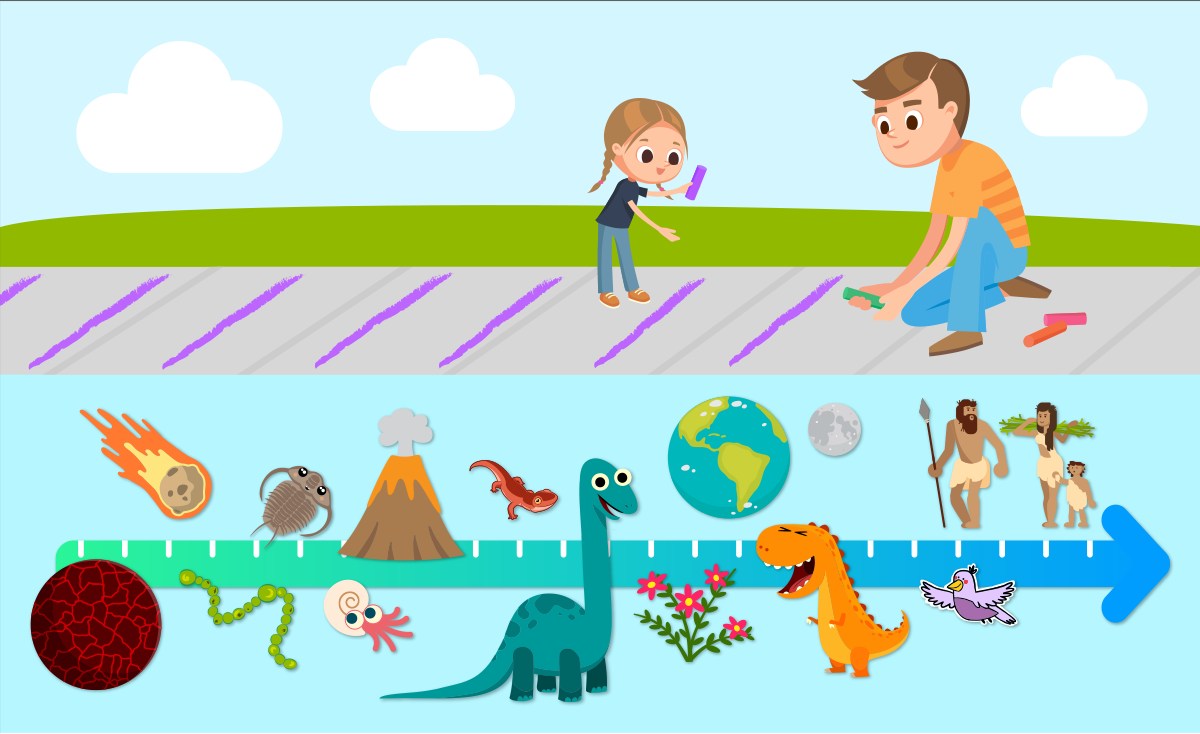By studying rocks, scientists have figured out how long the Earth has been around.
And the answer is: a long, long time.
Numbers this big are hard to imagine.

So heres an activity that will help.
You need:
In this activity, you will take a walk through time.
Every step you take will represent fifteen million years.

At one end of the sidewalk, use the sidewalk chalk to make a mark on the pavement.
The early Earth was very different from the way it is today.
Starting at this mark, walk seven paces along the sidewalk.

Walk another three paces.
It rains for hundreds of years, forming theoceans.
Walk another twenty paces.

This marks the beginning of a long period ofasteroids(space rocks) hitting the Earth.
Walk another twenty paces.
The long period of asteroid impacts has now ended.
Walk another twenty paces.
This is the earliest point in time that everyone agrees there waslife on earth.
At this time, life only lives in the ocean.
Now for the longest walk yet: Walk another seventy paces.
Walk another three paces.
Walk another twenty paces.
The ice age has now ended.
Walk another twenty paces.
Sometime around here, the firstcomplex cellsappear the kind that plants and animals are made of.
Walk another sixteen paces.
Notice that all life was single-celled for a long, long time.
Even today, single-celled life is much more diverse than multicellular life.
We just notice multicellular life more because its bigger and because it includes us!
Walk another twenty-four paces.
Up until this point, living things have made babies by making copies of themselves.
This is calledsexual reproduction, and it makes evolution move faster.
Walk another forty paces.
The earliest fossils ofanimalsare from this time a bang out of sea creature called sponges.
And from this point on, things get action-packed.
Walk another four paces.
These include members of the clam family, the insect family, and the starfish family.
Walk one more pace.
Now the firstbackboned animalsappear: fish without jaws.
The first members of a group of insect-like sea creatures calledtrilobitesappear as well.
All animals and plants still live only in the oceans; there is no life on land.
Walk another four paces.
Now the firstland plantsbegin to appear.
At first, theyre all small, like mosses.
Walk another two paces.
Now someinvertebrates have followed the plants onto land, to eat them.
In the sea, the firstjawed fishappear.
Walk another two paces.
The first trueinsectsand the firstsharksappear, and so do a group of squid-like creatures with spiral shells calledammonites.
Walk another two paces.
Now somebackboned animals have followed the invertebrates onto land, to eat them.
They would have looked like big salamanders.
Walk one more pace.
Some plants have now evolved to grow fromseeds, which have a protective covering.
Walk two more paces.
At this point, all the worlds continents have fused together into a single supercontinent, calledPangaea.
Walk one more pace.
This is the time of hugeforestsof trees, teeming with giant millipedes and dragonflies.
When these trees fossilized, they became coal, which we still use for energy today.
Walk two more paces.
Dimetrodon is often mistaken for a dinosaur, but its actually more closely related to you and me!
Besides, dinosaurs hadnt appeared yet.
Walk two more paces.
This is the time of the biggest massextinctionin the history of the Earth, which was triggered by volcanoes.
Lots of groups of animals died out, including the trilobites.
Walk two more paces.
The world has recovered from the extinction event, and the firstdinosaursappear.
Walk one more pace.
Now the firstmammalsappear: animals with fur who feed their babies with milk.
Walk two more paces.
The supercontinentPangaea is starting to break up.
Walk one more pace.
This is the time ofgiant long-necked dinosaurs, like Brontosaurus and Brachiosaurus.
At the same time, a group of small feathered dinosaurs learns how to fly.
Today, we call thembirds.
Walk two more paces.
Walk four more paces.
The dinosaurs have continued to dominate through all this time.
Now its the time ofTriceratops and Tyrannosaurus rex.
But walk one more pace and everything has changed.
A giant rock has fallen out of the sky, causing another majorextinction.
All dinosaurs except birds have died, and so have a lot of other creatures, including ammonites.
Now that the big dinosaurs are out of the way, mammals are diversifying like never before.
And now that ammonites are out of the way, bony fish are diversifying like never before.
Walk one more pace.
Walk one more pace.
The climate has gottencooler and drier.
Forests are giving way to grasslands, where herds of hoofed mammals roam.
Walk two more paces, and that takes you tonow.
(Make a mark with the sidewalk chalk.)
So much happened in that last step you took!
The Earth went through another ice age.
In the grand scheme of things, we only just got here.
And yet, weve already had an enormous influence on the Earth.
Can you still see the mark you made back at the beginning of the Earth?
Dont forget to follow us onTwitter,Instagram,Pinterest, andFacebook!
Original content 2019 Super Simple.
Not to be reprinted without express written permission.Terms of Service.